He baptized the country and kept seven concubines. She loved her son, so she made him watch her own orgies and dress up in ladies' tricks. He was pope and fathered sixteen children. At least. These ruling families fought for moral freedom long before the sexual revolution.
As always, all TOP10 items are based on the articles we publish. This time we decided to look at which of the crowned heads became famous for their behavior deviating from the sexual standards of a given era. You will be surprised what they were doing! You can find more texts on the themes of love, sex and betrayal in history HERE.
Here is our list of royal house members who could become precursors of the sexual revolution:
9. Mieszko I, who kept his own harem
Gall Anonim claimed that the first historical ruler of Poland before his baptism had as many as seven wives. The number may be questionable, but the very existence of a Piast harem - by no means! Having numerous wives was not uncommon among Slavic chiefs. In the company of seven wives, Vladimir the Great, the ruler of Rus, was to spend intoxicating nights before his baptism. In turn, the Pomeranian prince Warcisław was credited with having as many as twenty-four partners.
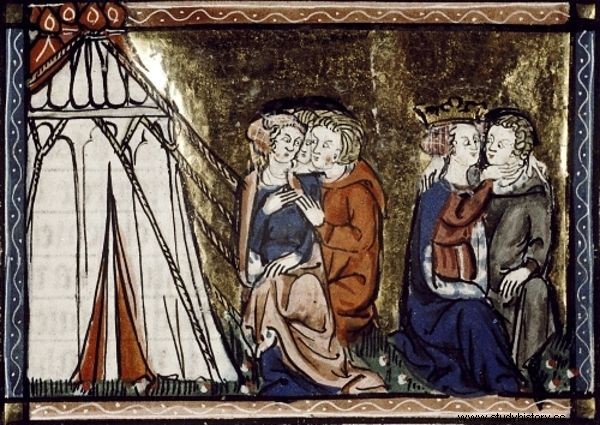
If something is in doubt, it is only the status of Mieszko's partners. And maybe their number ... (source:public domain).
Harem met the personal needs of the ruler, but also emphasized his wealth and power. After all, only a truly influential man could afford to provide beautiful clothes, jewelry, food and luxurious accommodation to not one, but several or a dozen women.
If anything is in doubt, it is the nature of similar relationships. The chronicler Wincenty Kadłubek, who wrote at the end of the 12th century, corrected Gall's story, claiming that Mieszko had not seven wives but "seven prostitutes", with whom he took turns to spend the nights and whom he only "called his wives" (read more on this topic).
8. Luisa, the daughter of the King of Belgium, who owed her sexual awakening to her elderly husband
Luisa, born in 1858, was the eldest daughter of King Leopold II of Belgium. At the age of sixteen, she married Philip von Sachsen-Coburg-Goth, almost twice her age. As Linda Rodriguez McRobbie writes:
The girl had no idea what to expect from her wedding night - no one ever realized her - and ran away as soon as she began to suspect what she was doing. saints . In her nightgown, she fled into the greenhouse.
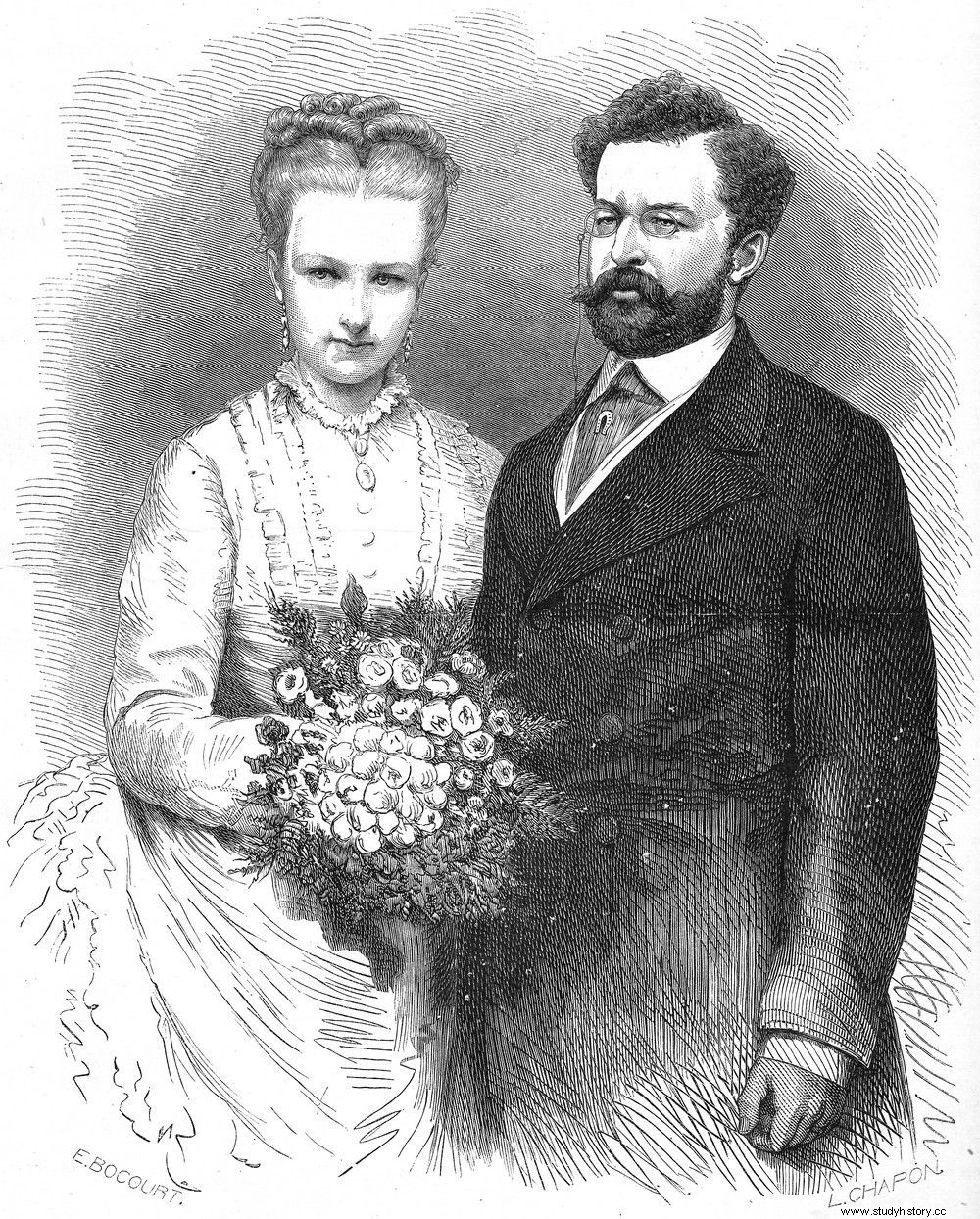
Luisa and Philip's ill-fated marriage started badly and then it got even worse. Etching based on a wedding photo from 1875 (designed by Etienne Bocourt, made by Léon-Louis Chapon, photography by Géruzet Frères; public domain).
Philip did not give up. He offered her lecherous readings and showed her peppery souvenirs from the Far East. The lessons were fruitful, even too much. When the spouses moved to Vienna, Luisa shone at the imperial court. Flirty, scandals and romance became her element . Even the birth of two children didn't stop her.
Twenty years after her marriage, Luisa fell in love with a Croatian aristocrat, eight years her junior, Count Gez Matačić. Soon she escaped with him to the French Riviera, and when they had spent all their money, they took refuge in Croatia. However, this was only the beginning of their adventures (read more about it).
7. Edward VIII, who fell in love with a divorced (and married) woman
When, in the early 1930s, Prince of Wales Edward met a certain Mrs. Simpson, an acquaintance of his then-mistress, nothing foreshadowed trouble. However, over time, her elegance, insolence and sharp tongue captivated him, and then everything happened in no time. He fell in love to death, not wanting to hear about any other woman.
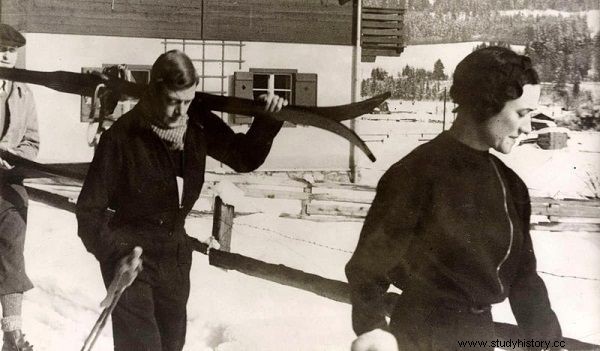
For a beloved woman, Edward faced the world and family. Pictured is Edward and Wallis in Kitzbühel, Austria, in February 1935 (source:public domain).
Everything would be fine if it weren't for the fact that Wallis Simpson was divorced and married. In a word:a woman who could not be accepted in any way by the distinguished monarch's family, rigidly pushed into the frame of etiquette. At first no one bothered with the heir to the throne's intimacy with another married woman (he had a weakness for them), in addition to having a dubious past ( apart from the fact that she had already divorced once, she was accused of numerous sexual excesses ). Meanwhile, out of spite, it turned out to be something permanent. Ba! Edward just couldn't live without her.
His "addiction" had become so deep that when he was to sit on the British throne after his father's death, he could not imagine the moment without his beloved Wallis at his side. He did not even want to hear about the proposal of one of the politicians to simply make her his mistress. He replied that it was out of the question, because Mrs. Simpson is a lady after all (read more about this).
This article has more than one page. Please select another one below to continue reading.Attention! You are not on the first page of the article. If you want to read from the beginning click here.
6. Pope Innocent VIII, who made no secret that he had children
Papal Nepotism, or the custom of appointing relatives to church offices, was initiated at the beginning of the 15th century by Marcin V. However, it was only Callixtus III, who came from Catalonia, that perfected this practice. Successive Holy Fathers took advantage of the increasingly liberal attitude of Italians towards illegitimate children.
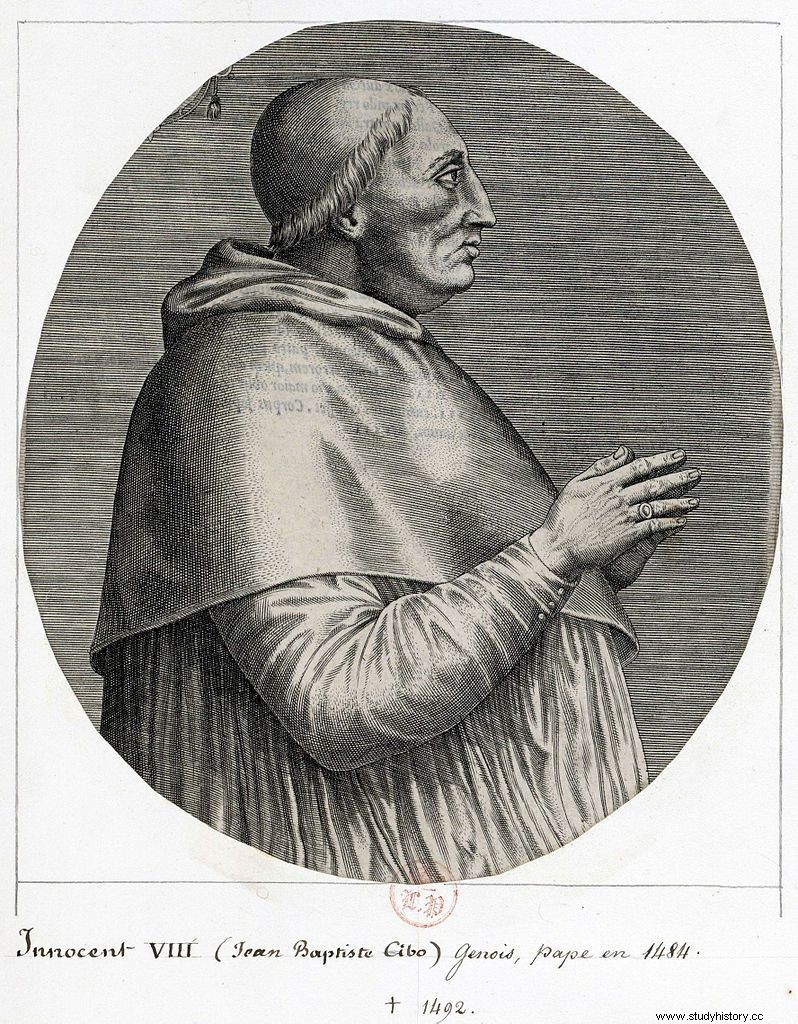
Pope Innocent VIII did not even hide the fact that he had children (source:public domain).
But it was only Pope Innocent VIII who was the first to hide from his two children. He probably had more of them ... As Dario Fo wrote in "The Pope's Daughter":
He was known as the "father of the people" as his loving activities during a life of bliss increased the number of his subjects by eight sons and eight daughters > .
5. Napoleon who openly advocated polygamy
It sounds progressive, but unfortunately the views of the French Emperor resulted from premises that today would be met with stiff opposition, and not only by feminists. We can find out about it best by reading the notes left by Count Emmanuel de Las Casesa - a companion of the dethroned monarch on the island of St. Helen.
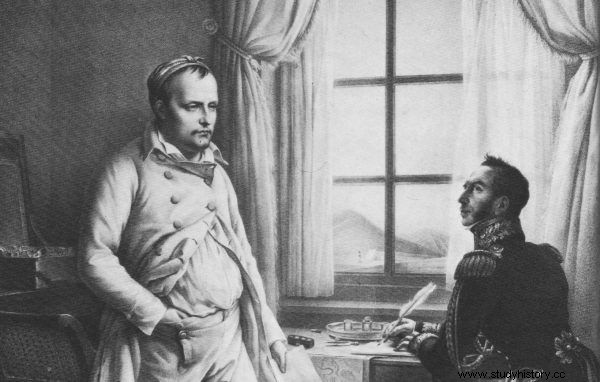
During his stay on the island of St. Helena Napoleon raised many issues in conversations with his friends, among them there were also considerations about women (source:public domain).
He describes in translation a walk, during which Napoleon delivered a rather long monologue, which also touches on the topic of polygamy. What did the leader who conquered almost all of Europe think about women and their role in men's lives?
A man needs a woman to bear children. One woman cannot be enough for him. She is his woman when she carries a child in her womb, when she nourishes the infant. She cannot be his companion when she is sick and also if she cannot give him a child. Due to nature, a man, regardless of age, does not know this kind of limitation, must therefore have several women .
4. Ludwika Maria Gonzaga de Nevers, who turned sex into a powerful political weapon
Ludwika Maria Gonzaga de Nevers, wife of two Polish Vasas and almost a sister-in-law of the King of France, was not beaten in the dark. Although she experienced a painful heartbreak in her youth, she drew conclusions from it. After arriving in Poland, she built a group of faithful supporters in the country from scratch. In addition to the usual methods of skilful diplomats, such as bribery, paying salaries to magnates, or mourning them with promises of honors and offices, she went a step further. The Queen used a weapon hitherto underestimated - female charms to gain influence.
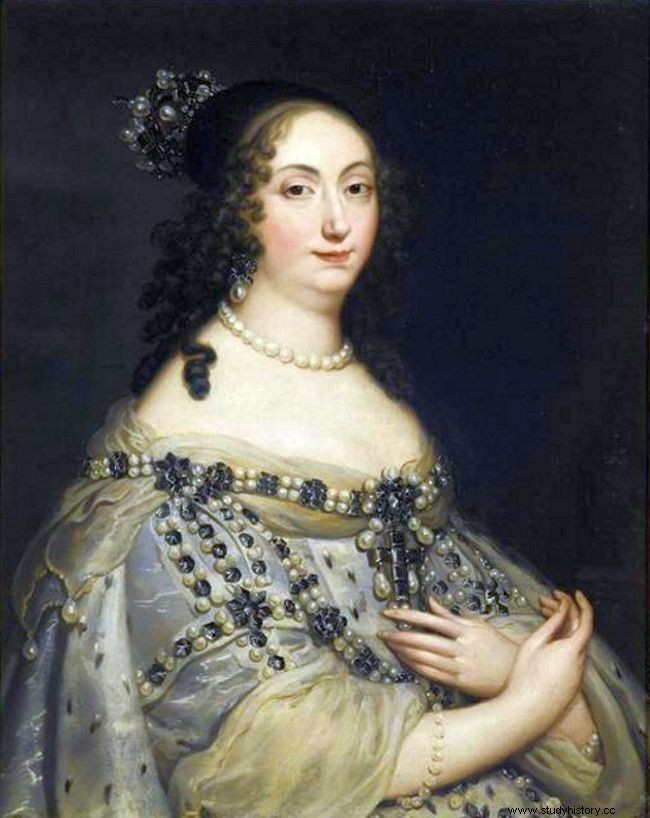
Ludwika Maria - here in the portrait of Justus van Egmont - trained her maids well. Even after her death, as the foremost ladies of the Republic, they did not give up their intrigues even for a moment (source:public domain).
The queen's secret weapon turned out to be ... her maids. Girls, young, beautiful and blindly devoted to their mistress, who very quickly became the eaters of men's hearts . Of course, Maria Ludwika did not plan to arrange a private brothel at the court and win over the crown lords in this way. Not at all! Everything was supposed to be "godly".
Ludwika Maria personally arranged the marriages of her ladies of the court and they were wonderful marriages. Each wedding was to be of her sole interest. Caught by a French, the Polish magnate, whether he wanted it or not, became an ally of the queen and the pro-French party (read more on this topic).
3. Henry III Walezy, who appeared in a female disguise
Katarzyna Medycejska condemned the playful games of her courtiers, who, although appearing as modest and virtuous maidens, led an exceptionally lush sex life ... and without the participation of men . However, even though she was a devout Catholic, she did not shy away from games and debauchery. Her son, Henryk, the future king of Poland, had a similar attitude.

Ball at King Henry III by an unknown author. Henryk came in men's clothes ... We know, however, that it happened otherwise (source:public domain).
A description of the feast organized by Katarzyna Medycejska in honor of her son from the "Diary of Henryk III" can be found in the preface to the Polish edition of "Lives of the playful ladies" written by Tadeusz Boy-Żeleński. The prince's victory at d'Alencon was celebrated at Chenonceau Castle.
The main character of the feta, Henryk, appeared in a female disguise, in a deeply cut outfit that exposed her breasts. The then sixty-year-old Catherine de Medici led an orgy in which her daughter Małgorzata and her daughter-in-law Luiza Lorraine also took part . Half-naked ladies of the court were dressed in men's clothes (read more about this).
2. Catherine II, or a truly liberated woman
Catherine became a Tsarina in 1762 as a result of a coup d'état carried out mainly by her lover Grzegorz Orłów and his four brothers. The handsome and graceful Orlov became her official favorite - the first of ten. Not counting fleeting romances, of course.
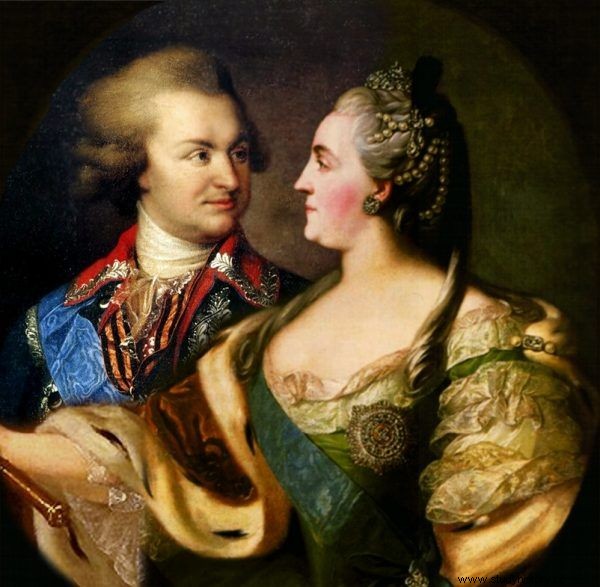
"Golden Pheasant" and his "hot woman" in a contemporary collage of Potemkin's portrait by Lampi and Catherine II by Fyodor Rokotov (author:Shakko, license CC BY-SA 3.0).
The one-eyed colossus, the smart Grzegorz Potemkin, became her real passion. Perhaps he even secretly became the husband of the tsarina - and he was certainly her constant associate and almost co-ruler. He aroused powerful emotions in Katarzyna. In "Secrets of the Tsars" we read that the empress invented a whole arsenal of caressing names for him, such as: "golden hen", "nice toy", "dear mascot", "soul mate", "favorite doll" (…).
In her letters, she confided to him, among other things, that she felt with him "like a cat in heat" and called him "a lion in the jungle". Their romance, though violent, did not last long, and Potemkin gave way to more gains. She did not avoid even men who were much younger than her - she was 38 years older than her last favorite, Platon Zubov (read more on this topic).
1. Edward II, who paid for his love for a beautiful knight with his life
Chroniclers have repeatedly described Edward II's love for Gaveston, the Gascon knight, using words such as beyond measure and reason , unrestrained , immoderate and excessive . The author of "The Life of Edward II" wrote: In fact, I do not remember that I have ever heard one man love the other so ... Our king was incapable of moderate affect .
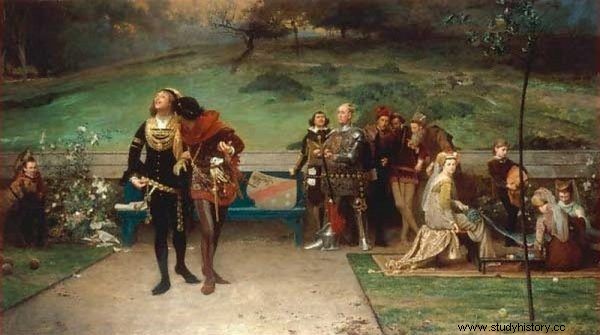
The king, despite the unfavorable looks of the courtiers, spent a nice time with his beloved (Marcus Stone's painting "Edward II and his favorite, Piers Gaveston", public domain).
If you believe the records of the "Chronicle of the Civil Wars of Edward II", the prince fell in love with the Breast at first sight and then "joined him in spite of the whole world with unbreakable bonds of love". And although there is no real evidence that the prince entered into a deeper relationship with the Gasconian before 1305, he certainly had a serious quarrel with his father over him, for which the king not only cut off his son from money, but also removed several courtiers from his entourage. including Gaveston.
Despite these attempts, Edward did not lose touch with his alleged lover. He took care of his fate, arranging for him, among other things, a favorable marriage. He also preferred it to his wife, Izabela, the beloved daughter of Philip IV the Beautiful. The presence of the favorite at the royal court, however, aroused more and more dissatisfaction of the mighty , which led to the tragic ending ... (read more about it).
